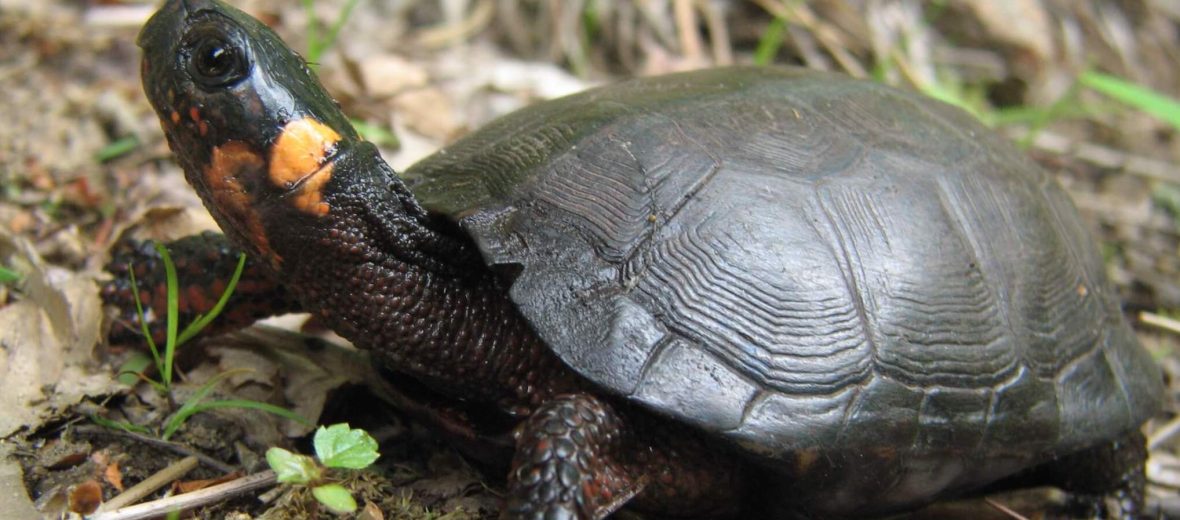
The bog turtle can be found in the eastern and northeastern United States. They prefer bogs, calcareous wetlands (locations containing lime), meadows, spring seeps, marshes, and habitats containing both wet and dry regions. Sadly, these turtles are faced with many threats. These threats are habitat loss and destruction at the hands of residential and commercial developments, the logging industry, farming, and the construction of roads & railroads (that divide their territories and result in vehicle strike – being hit by vehicles); hunting; trapping; disturbances by human activities; invasive species (and with them disease and competition for food); and climate change (resulting in draughts and flooding that cause habitat alterations). As a result, the IUCN lists these little turtles as Critically Endangered. Their population trend is unknown.
First the Stats…
Scientific name: Glyptemys muhlenbergii
Weight: Up to 4 ounces
Length: Up to 4.5 inches
Lifespan: Up to 50 years
Now on to the Facts!
1.) Bog turtles are diurnal (active during the day).
2.) These turtles were last surveyed in August of 2010.
3.) They were first described in 1801, in Pennsylvania.
4.) Even though they look like spotted turtles or painted turtles, they are more closely related to wood turtles.
5.) These turtles are tough to research in the wild because they are shy and spend the majority of their lives buried in mud, brumating (hibernation for reptiles) for the winter.
But wait, there’s more on the bog turtle!
6.) They spend their warmer months searching for food, basking (warming up in the sun), or mating.
7.) If it gets too hot, they may estivate (a state of rest designed to avoid overheating) briefly, or take up shelter in a nearby tunnel or burrow.
Did you know…?
New Jersey’s state reptile is the bog turtle.
8.) In the cooler months, they can sometimes take refuge in seeps or burrows that can contain up to 12 other turtles; even various species of other turtles.
9.) They stay in brumation until the temperature reaches at least 61°F.
10.) A group of turtles is called a bale, creep, dole, nest, or turn.
But wait, there’s still more on the bog turtle!
11.) Bog turtles feast on duckweed and other aquatic plants, berries, seeds, snails, slugs, earthworms, insects, a variety of other invertebrates, frogs, juvenile (pinky) rats and pinky mice, and will even eat carrion (dead animals).
12.) Minks, otters, and raccoons all prey on the bog turtle.
Did you know…?
These cute critters are the smallest known turtle in North America.
13.) Females breed up to twice a year or sometimes not at all. Males attempt to breed as many times as possible each season.
14.) The female is gravid (pregnant) for up to 65 days before laying her up to 6 eggs.
15.) Eggs hatch in up to 80 days. Like other reptiles, they are born precocial (totally self sufficient at birth).
But wait, there’s still a little more on the bog turtle!
16.) These turtles are not only territorial but very defensive. They will easily charge another male if they venture as close as 6 inches away.
17.) Fights between males often result in biting each other and tucking their head into their carapace and ramming one another, till 1 turtle backs down and retreats.
Did you know…?
Due to these turtles being potentially slow to reproduce, and since they are listed as Critically Endangered, these turtles fetch a high price from private breeders; sometimes over $1,300 each!
18.) Females too are defensive and will charge an approaching female turtle, in order to guard her nest.
19.) You can tell the age of a bog turtle by counting the rings on a scute, sans the first ring, as that is developed prebirth.
20.) Since their shells are among the softer of turtle shells, it provides little to no protection against predators. So, they will often flee and bury themselves in mud to escape predation.
Now a Short Bog Turtle Video!
Be sure to share & comment below! Also, check out the Critter Science YouTube channel. Videos added regularly!
Want to suggest a critter for me to write about? Let me know here.
Some source material acquired from: Wikipedia & IUCN
Photo credit: New Jersey Fish & Wildlife



